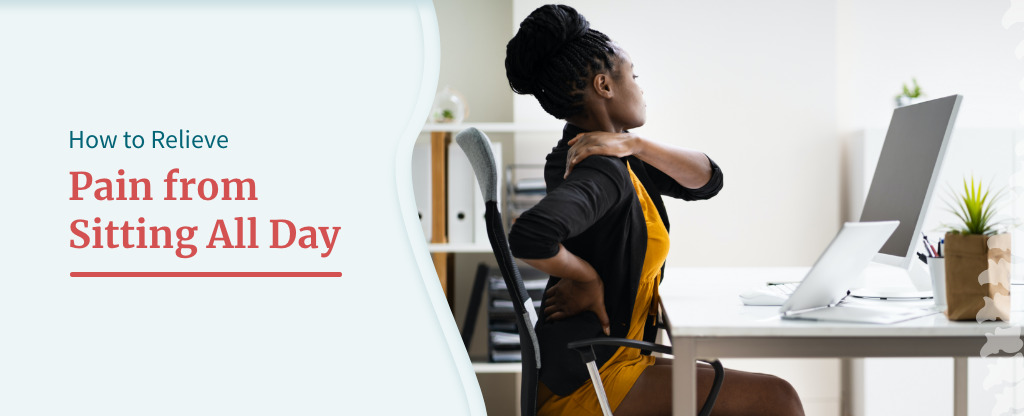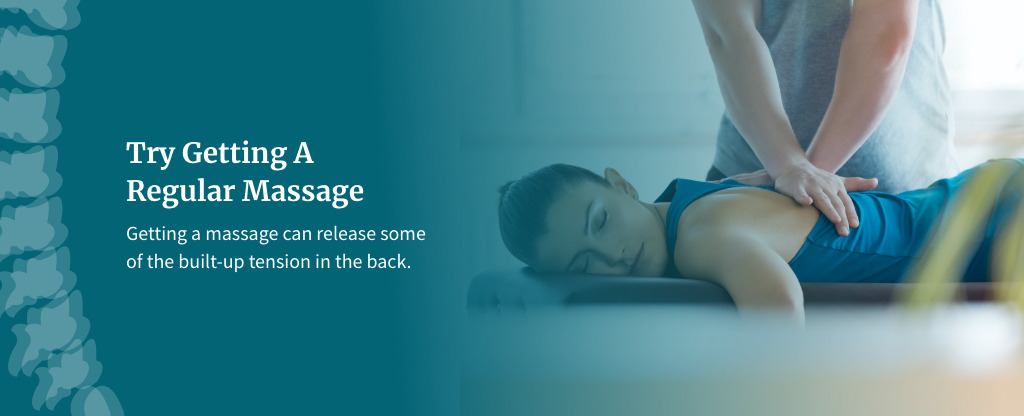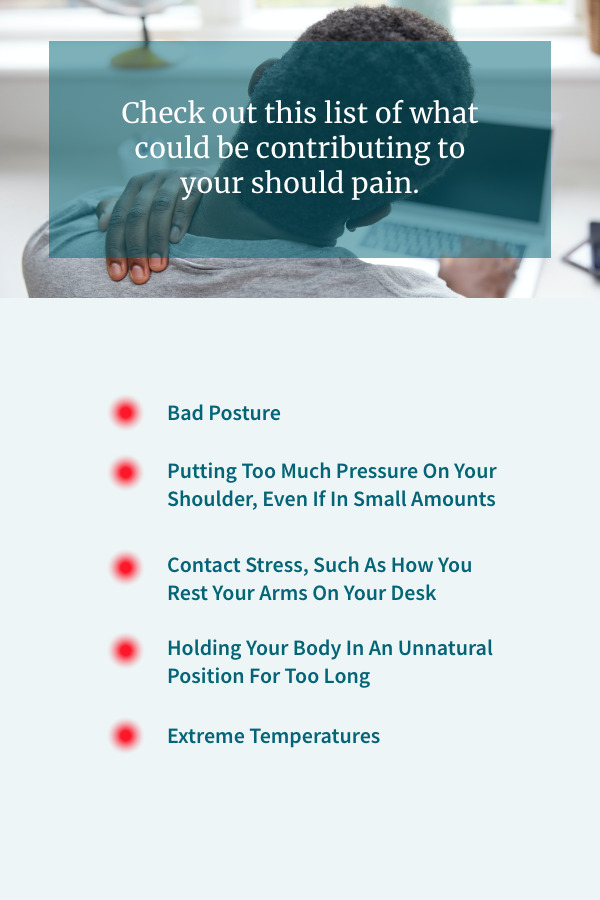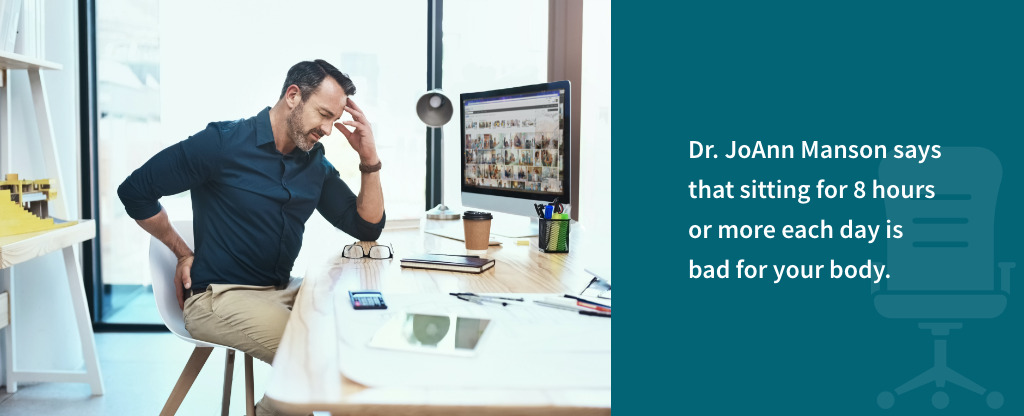
Do you have an office job or one that requires you to sit for long periods of time? Or maybe even requires you to sit for the entire day? If you do, you are probably also familiar with the stress that puts on your body, such as back and neck pains. You may even worry about your posture.
Well, worry no more! The Orthopedic Institute of Pennsylvania (OIP) offers a number of services to relieve some of those pains, as well as provides proper care for the affected areas.
Back Pain
Back pain is one of the most common pains that results from sitting at a desk all day. There are two types of back pain: upper and lower. Each can be caused by different things, but both are pains you can get from sitting at your desk all day. Let’s take a deeper look at each one.

Upper Back Pain
There are 12 bones within your upper back. The first is at the base of your neck and the twelfth ends just below your ribcage. Upper back pain consists of any pain that occurs within this area.
Most of the time, upper back pain is caused by bad posture. While sitting at your desk, it’s easy to slouch over in your chair without realizing it. But try out these tricks to prevent those pains.
- Take regular breaks from sitting: Every once in a while, try standing up and walking around. This will relieve some of the stress put on your body from sitting all day, and it will also allow you to move other muscles in your body.
- Take stretch breaks: This is very similar to the first suggestion, but here, you want to make sure you are actually stretching your muscles so they don’t tighten up.
- Try getting a regular massage: Getting a massage can release some of the built-up tension in the back.
- Work with a physical therapist: A physical therapist can help you work on keeping your joints healthy and strengthening your muscles.
- Work on your posture: Focus on your posture, whether you’re sitting down or walking. This is huge in preventing back pain.
Most back pains can be fixed with simple lifestyle changes. However, if your pain persists, we’d love to meet you and check out those issues you’re having!
Lower Back Pain
Over 50% of Americans will experience lower back pain throughout their lifetime.
Lower back pain is pain experienced in the vertebrae known as L1 through L5. We have discs which are sacs that prevent your vertebrae from rubbing together. A common cause of lower back pain is bad posture, which puts strain on those discs.
Like upper back pain, lower back pain can probably be fixed by lifestyle changes, one of the most common being working on your posture. But there may be something more going on, such as:
- Sciatica: pain that runs from the base of the spine down your legs
- Herniated disc: pressure on the disc that causes it to reshape, which triggers lower back pain
- Muscle strain/lumbar strain: overuse of the muscles that causes pain to stretch into your buttocks (but not into the legs)
- Degenerative disc disorder: when discs in the lower back are damaged
If your back pain continues after trying to correct your bad habits or you’re worried you may be experiencing one of the conditions above, visit our Center for Spine Care in Camp Hill. Our physicians are able to treat most of our patients without the use of surgery.

Shoulder Pain
This may seem like a strange pain to have from sitting, but it definitely happens. Well, what could be causing shoulder pain at your desk job? Small, repetitive activities can place stress on the muscles in your shoulder, such as using a mouse or keyboard all day. In addition, check out this list of what could be contributing to your shoulder pain.
- Bad posture
- Putting too much pressure on your shoulder, even if in small amounts
- Contact stress, such as how you rest your arms on your desk
- Holding your body in an unnatural position for too long
- Extreme temperatures
Surprisingly, a lot of repetitive strain injuries (RSI) are actually computer-related. So study your everyday habits while at your desk or working on your computer and see if you’re making any movements that could be causing that shoulder pain.
What Can OIP Do for Your Shoulder Pain?
Once we figure out what is causing your pain, we can choose the best treatment plan for you. Here are some of the options:
- Rest: Resting your sore and hurting muscles can keep you from overusing the muscles long enough for them to begin healing.
- Physical or occupational therapy: There are always exercises and activities that can improve stability and help relieve some of that pain.
- Medications and/or injections: Certain medicines and injections can be used to treat pains that result from arthritis.
- Small surgical procedures: Some causes of pain may require a simple surgery. We can usually perform these types of procedures in a minimally invasive manner.
We prefer to visit the above methods to see if one of them will work, but sometimes, there is something more serious going on. If this is the case, a more in-depth surgery or treatment plan is the route we have to take. OIP will make sure it does what is best for you physically and financially.
Elbow Pain
Like shoulder pain, you wouldn’t expect that this kind of pain would come from sitting at your desk, but here we are. Maybe you lean on a desk all day, putting stress on your elbow and joints. Maybe you move your elbows in harsh ways all day while sitting at your desk. Whatever the case may be, take a look at these few tips for relieving pain.
- Rest: The most obvious answer for relieving pain is rest. Take the stress off your elbow. You could also be overusing it, which could be causing inflammation.
- Heat: Most of the time, you’re told to ice, but for elbow pain, applying heat could stimulate blood flow, which encourages healing.
- Stretching: Stretching sore muscles can help if maybe your muscles have just tightened up. Try stretching you arm out straight with your palm facing the ceiling. Slowly bring your fingers into your palms. Hold this for 30 seconds. Turn you arm over, where your palm is facing the floor, and repeat the stretch.
- Bracing: Wearing a brace over the affected area can keep the muscles in position and prohibit them from moving, which can aid the healing process.
If none of these work, OIP can help! We take your pain and recovery as seriously as you do, and we want to make sure that we take care of you the best way possible.
Hip Pain
The hip is the largest ball-and-socket joint in our body and is where the bones in the upper part of the leg connect to your body. The hip will support you while walking, running, or any other activity you may take part in. But the hip will also support you while you’re sitting. In fact, your hip bends to support your weight when you’re sitting down, which can put stress on the hip and cause you pain.
Sometimes, hip pain is just a result of sitting down for too long, so you may be able to stand, move around and stretch to relieve the pains. But sometimes, your hip pain could mean there is something more going on with your body.
The kind of pain you are experiencing and where you’re experiencing it can help you determine what the issue may be. Pains on the outer portion of the hip are usually related to your ligaments, tendons and/or muscles. But pains on the inner portion of the hip are usually tied to health issues related to your hip and its connecting joints. There’s also the possibility that your back pain has worked its way into your hip, known as referred pain.
Why Do I Have Hip Pains?
As with all pains related to sitting down for long periods of time, it could be a few different things.
- Bad posture: This puts strain on all parts of your body.
- Crossing your legs: Crossed legs can put stress on either hip and cause pain.
- Leaning to either side: Leaning one way or the other puts stress on your hips.
- Sitting unevenly: Sitting on an uneven surface can strain your hips.
There could definitely be something more serious going on, so if making these alterations while sitting doesn’t help, OIP can check out the hip to look for the cause. We can treat your pains at our Harrisburg location by trying some of our non-surgical methods.

Knee Pain
Pains in the knee can be a result of a previous injury, but they can also be overuse, wear and tear or maybe it’s just the way you’re sitting. While you may not think you would be putting stress on your knee while sitting, you definitely can. So what could be causing those knee pains?
- Sitting for too long: Dr. JoAnn Manson says that sitting for 8 hours or more each day is bad for your body.
- Sitting in an abnormal position: If you’re sitting with your knees in random positions, it could be putting unnecessary stress on them.
- Furniture: If you’re sitting on a chair or couch with an odd design, it could be causing you to strain your muscles and body parts.
These are the most common reasons you could be having knee pains in relation to sitting at your desk all day. However, as always, there can definitely be an underlying condition causing these pains. If you feel you need to have your knees examined, our physicians can take a look to determine the problem.
Most people tend to avoid doctors when it comes to knees because they believe surgery is the only way to fix the pain. However, our physicians will work through all non-surgical treatment methods before surgery. We will do our best to find a method that works for you. We won’t pressure you into surgery unless we believe it is the only way to help you relieve those pains.
How Can I Alleviate Knee Pains While Sitting?
There are some things you can work on to prevent knee pains.
- Pick an office chair that supports your spinal curves. This can help alleviate some of those other pains from sitting as well.
- Adjust your chair so that your feet are flat on the floor and your thighs are parallel to the floor. This will help with your posture and make sure your knees aren’t bent at ridiculous angles. If for any reason you are unable to adjust your chair to accomplish these tasks, consider some sort of footrest. Your feet need to be flat on a surface below you.
- Adjust your armrests so that your arms can rest in a relaxed position.
- Make sure your desk and chair allows room for your knees, thighs and feet.
- When working at your desk, make sure your work is directly in front of you and not too far away. This will keep you from moving into odd positions and putting stress on your body.
Another idea, which may seem very odd, is to look into a standing desk. This keeps you from sitting too long and bending your body at unnatural angles.
If these adjustments don’t help with your pain, reach out to our staff so we can evaluate your pains and struggles.

Pain Management
Now let’s talk about how to manage your pain. It’s important to note that pain is a symptom. Usually, your pain means that there’s something underlying. In this case, the underlying problem is how you’re sitting while at a desk, at work, etc.
If you’ve tried our tips and tricks previously mentioned and your pain is still an issue, contact us today! We will take a look to make sure you don’t have a more serious problem, such as arthritis or chronic joint pain. Whether it is something more or just pain associated with sitting at a desk all day, we will come up with a plan to treat your pain.
You can call our main line (717) 761-5530 or our 24/7 emergency advice hotline (855) OUCH OIP ((855) 682-4647. You can also request an appointment by filling out our online form. We do welcome walk-ins though, so you can visit our Camp Hill or Harrisburg Orthopedic Injury Clinic and see a physician today!


